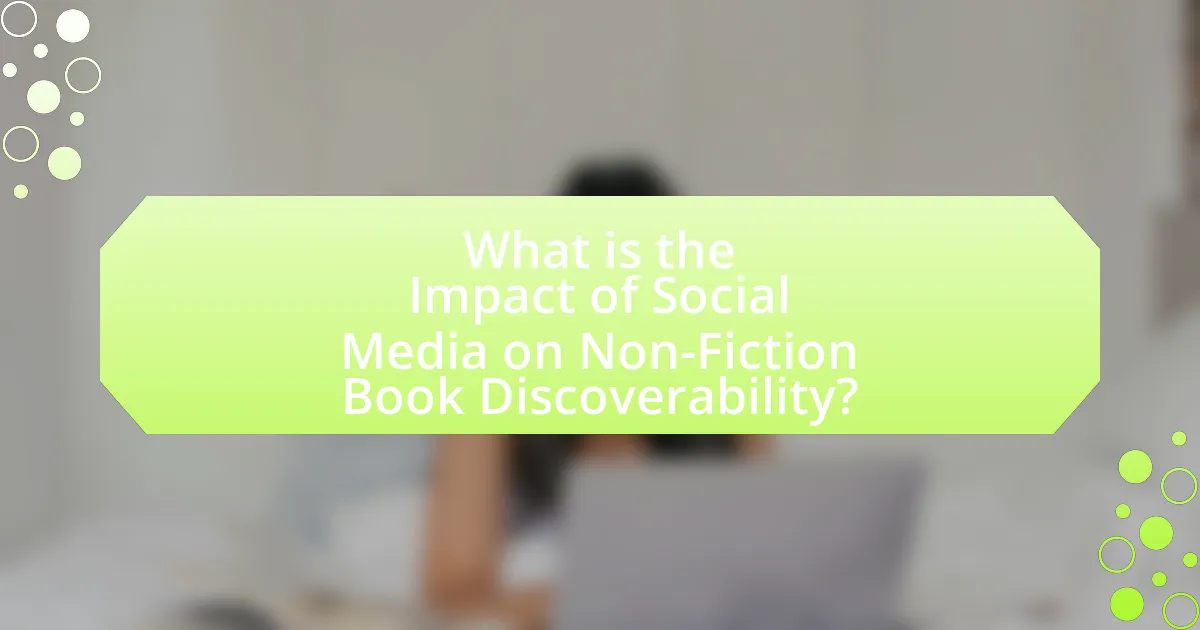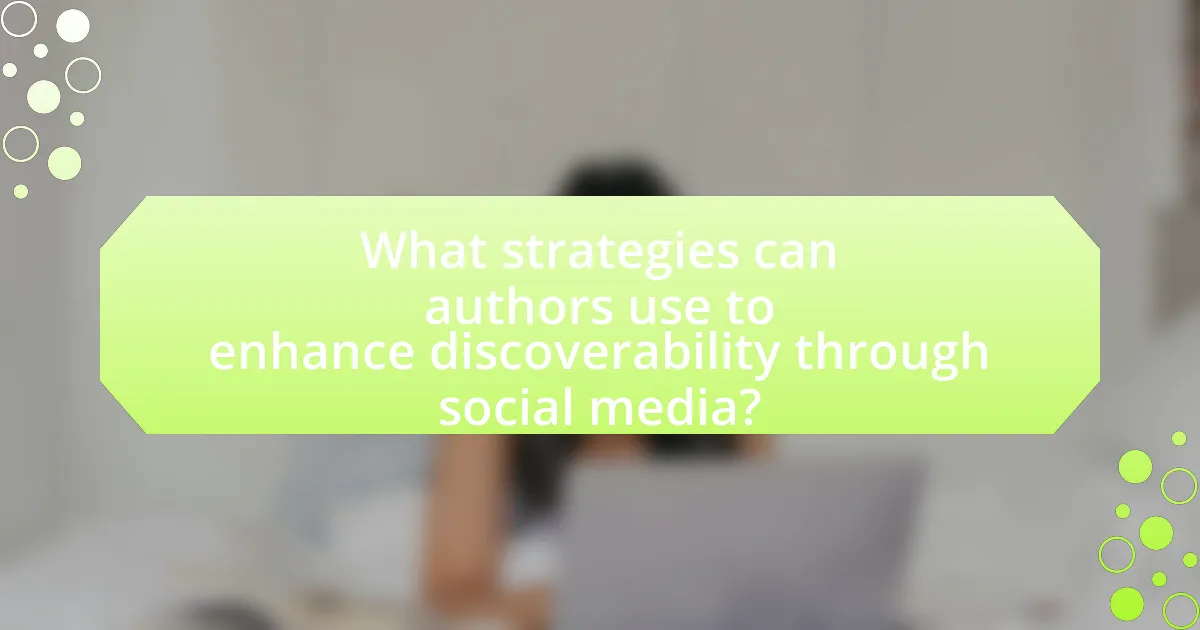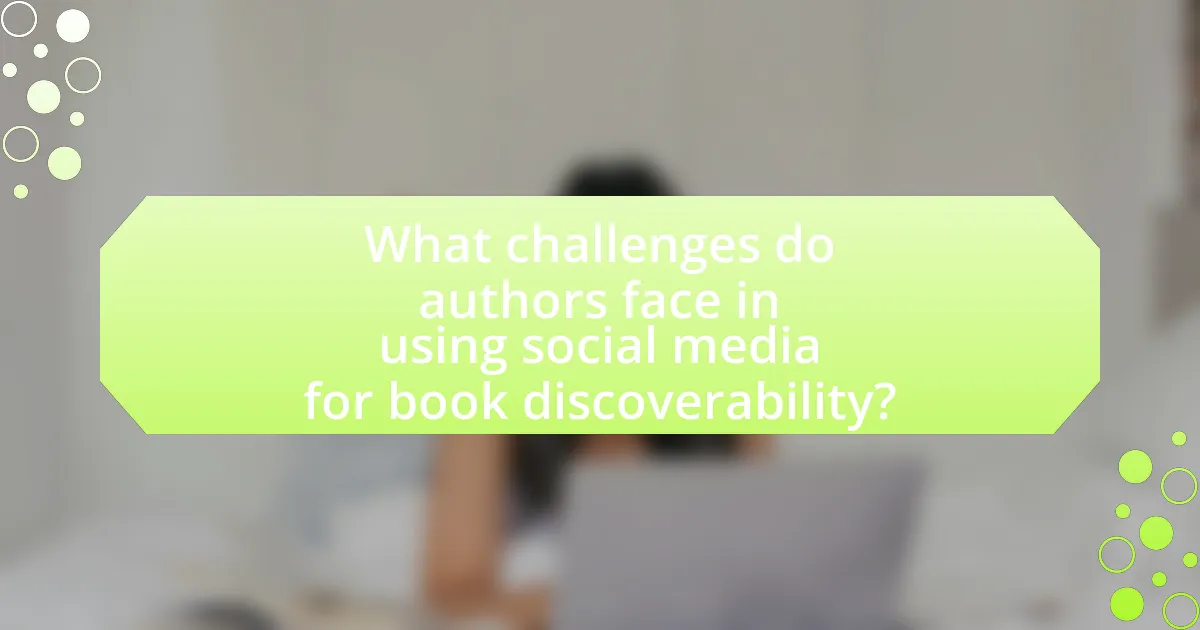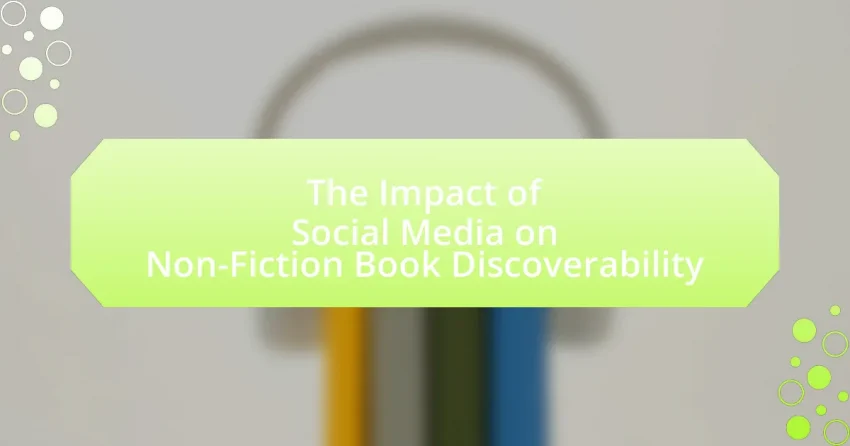The article examines the significant impact of social media on the discoverability of non-fiction books. It highlights how platforms like Twitter, Instagram, and Facebook enhance visibility through direct engagement between authors and readers, targeted advertising, and user-generated content such as reviews. The role of social media algorithms in curating content for specific audiences is discussed, along with strategies authors can employ to maximize their reach and sales. Additionally, the article addresses challenges authors face in navigating social media, including content oversaturation and audience engagement, while providing best practices for effective promotion and measuring success.

What is the Impact of Social Media on Non-Fiction Book Discoverability?
Social media significantly enhances the discoverability of non-fiction books by providing authors and publishers with platforms to reach wider audiences. Through targeted advertising, engaging content, and community interactions, social media allows for direct connections between authors and potential readers. For instance, a study by the Pew Research Center indicates that 69% of adults in the U.S. use social media, which facilitates the sharing of book recommendations and reviews, thereby increasing visibility. Additionally, platforms like Instagram and Twitter enable authors to showcase their expertise and build a following, further driving interest in their non-fiction works.
How does social media influence the visibility of non-fiction books?
Social media significantly enhances the visibility of non-fiction books by facilitating direct engagement between authors and readers. Platforms like Twitter, Instagram, and Facebook allow authors to share insights, promote their work, and connect with niche audiences, which increases discoverability. For instance, a study by the Pew Research Center found that 72% of adults use at least one social media site, providing a vast audience for book promotion. Additionally, user-generated content, such as reviews and recommendations, can amplify a book’s reach, as 79% of consumers trust online reviews as much as personal recommendations. This interaction not only boosts visibility but also fosters community discussions around the themes of non-fiction works, further enhancing their appeal and reach.
What role do social media algorithms play in book discoverability?
Social media algorithms significantly enhance book discoverability by curating content that aligns with user preferences and behaviors. These algorithms analyze user interactions, such as likes, shares, and comments, to promote books that are likely to resonate with specific audiences. For instance, platforms like Facebook and Instagram utilize machine learning to prioritize posts about books that have received high engagement, thereby increasing visibility among potential readers. Research indicates that 70% of users discover new books through social media, highlighting the effectiveness of these algorithms in connecting authors and publishers with targeted demographics.
How do user-generated content and reviews affect non-fiction book visibility?
User-generated content and reviews significantly enhance non-fiction book visibility by increasing engagement and credibility. When readers share their thoughts and experiences, they create authentic endorsements that can influence potential buyers. According to a study by BrightLocal, 91% of consumers read online reviews, and 84% trust them as much as personal recommendations. This trust translates into higher visibility for non-fiction books, as positive reviews can lead to increased sales and improved rankings on platforms like Amazon. Furthermore, user-generated content often gets shared across social media, amplifying reach and attracting new audiences, which further boosts the book’s discoverability.
Why is social media important for authors and publishers of non-fiction?
Social media is important for authors and publishers of non-fiction because it enhances visibility and engagement with target audiences. By utilizing platforms like Twitter, Facebook, and Instagram, authors can share insights, promote their work, and connect with readers directly. Research indicates that 70% of consumers are more likely to purchase a book after engaging with the author on social media, demonstrating its effectiveness in driving sales and fostering community. Additionally, social media allows for real-time feedback and discussions, which can inform future projects and marketing strategies, ultimately increasing the discoverability of non-fiction works.
What are the key benefits of using social media for book promotion?
The key benefits of using social media for book promotion include increased visibility, direct engagement with readers, and cost-effectiveness. Social media platforms allow authors to reach a wider audience, as over 4.5 billion people use social media globally, providing a vast potential market for book promotion. Direct engagement with readers fosters community and loyalty, as authors can interact with their audience through comments, shares, and live sessions. Additionally, social media marketing is often more affordable than traditional advertising methods, enabling authors to promote their books without significant financial investment. These factors collectively enhance discoverability and sales potential for non-fiction books.
How can social media engagement lead to increased sales for non-fiction books?
Social media engagement can lead to increased sales for non-fiction books by enhancing visibility and fostering community interaction. When authors and publishers actively engage with their audience on platforms like Twitter, Facebook, and Instagram, they create a direct line of communication that builds trust and interest in their work. According to a study by the Pew Research Center, 69% of adults in the U.S. use social media, making it a powerful tool for reaching potential readers. Engaging content, such as informative posts, live Q&A sessions, and reader polls, can stimulate discussions and encourage shares, which amplifies reach. Additionally, social media allows for targeted advertising, enabling authors to promote their books to specific demographics that are more likely to be interested in their subject matter, thereby increasing the likelihood of sales.

What strategies can authors use to enhance discoverability through social media?
Authors can enhance discoverability through social media by consistently engaging with their audience, utilizing targeted hashtags, and collaborating with influencers. Engaging with the audience fosters a community around the author’s work, which can lead to organic sharing and increased visibility. Targeted hashtags help categorize content, making it easier for potential readers to find relevant posts; for instance, using hashtags like #NonFiction or #BookRecommendations can attract specific audiences. Collaborating with influencers allows authors to tap into established audiences, as influencers often have a loyal following that trusts their recommendations, thereby increasing the likelihood of book discovery. According to a study by the Pew Research Center, 69% of adults in the U.S. use social media, indicating a vast potential audience for authors to reach through these strategies.
How can authors effectively utilize different social media platforms?
Authors can effectively utilize different social media platforms by tailoring their content to fit the unique characteristics and audience of each platform. For instance, on Twitter, authors can engage in conversations and share quick updates or insights, while on Instagram, they can use visuals to showcase their book covers or behind-the-scenes content. Research indicates that 70% of consumers are more likely to buy a product after seeing it on social media, highlighting the importance of a strong online presence. Additionally, platforms like Facebook allow for community building through groups, where authors can interact with readers and foster discussions about their work. By strategically using each platform’s strengths, authors can enhance their visibility and connect with potential readers effectively.
What are the best practices for promoting non-fiction books on Instagram?
The best practices for promoting non-fiction books on Instagram include creating visually appealing content, utilizing relevant hashtags, engaging with followers, and collaborating with influencers. Visually appealing content, such as high-quality images of the book cover, infographics, or quotes from the book, captures attention and encourages sharing. Using relevant hashtags increases discoverability; for instance, hashtags like #NonFiction, #BookRecommendations, and #AuthorLife can connect posts to broader conversations. Engaging with followers through comments, polls, and stories fosters community and encourages interaction, which can lead to increased visibility. Collaborating with influencers or other authors can expand reach, as their established audiences may be interested in the non-fiction book being promoted. These strategies are supported by research indicating that visual content is more likely to be shared on social media, enhancing discoverability and engagement.
How can Twitter be leveraged for non-fiction book marketing?
Twitter can be leveraged for non-fiction book marketing by utilizing its platform for targeted engagement, content sharing, and community building. Authors can create a dedicated profile to share insights, quotes, and relevant information from their books, which can attract followers interested in the subject matter. Engaging with relevant hashtags, such as #NonFiction or #BookRecommendations, allows authors to reach a broader audience and connect with potential readers.
Additionally, participating in Twitter chats and discussions related to the book’s themes can enhance visibility and establish the author as an authority in the field. According to a study by the Pew Research Center, 42% of Twitter users have discovered new books through the platform, highlighting its effectiveness in reaching potential readers. By consistently sharing valuable content and interacting with followers, authors can effectively market their non-fiction books on Twitter.
What types of content should authors share on social media?
Authors should share a variety of content on social media, including excerpts from their books, behind-the-scenes insights into their writing process, and engaging visuals related to their topics. Sharing book excerpts allows potential readers to sample the author’s style and content, while behind-the-scenes insights foster a personal connection and build interest in the author’s journey. Engaging visuals, such as infographics or relevant images, can enhance understanding and attract attention, making the content more shareable. Research indicates that posts with images receive 94% more views than those without, highlighting the effectiveness of visual content in increasing engagement.
How can authors create engaging posts that resonate with their audience?
Authors can create engaging posts that resonate with their audience by understanding their audience’s interests and preferences, and tailoring content accordingly. Research indicates that posts featuring storytelling elements, relatable experiences, and interactive components, such as polls or questions, significantly increase engagement rates. For instance, a study by BuzzSumo found that content with emotional appeal generates 2.5 times more shares than neutral content. Additionally, using visuals, such as images or videos, can enhance engagement, as posts with visuals receive 94% more views than those without, according to a report by HubSpot. By consistently analyzing audience feedback and engagement metrics, authors can refine their approach to ensure their posts remain relevant and captivating.
What role do visuals and multimedia play in promoting non-fiction books?
Visuals and multimedia significantly enhance the promotion of non-fiction books by increasing engagement and improving information retention. Research indicates that content with relevant images receives 94% more views than text-only content, demonstrating the effectiveness of visuals in capturing attention. Additionally, multimedia elements such as videos and infographics can simplify complex information, making it more accessible and appealing to a broader audience. This is particularly important in the context of social media, where visually-driven platforms like Instagram and TikTok can amplify a book’s reach and visibility, leading to higher discoverability and potential sales.

What challenges do authors face in using social media for book discoverability?
Authors face several challenges in using social media for book discoverability, including oversaturation of content, algorithm changes, and audience engagement. The oversaturation of content makes it difficult for individual authors to stand out, as millions of posts compete for attention daily. Additionally, social media platforms frequently update their algorithms, which can limit the visibility of an author’s posts, making it harder to reach potential readers. Furthermore, engaging an audience requires consistent interaction and quality content, which can be time-consuming and challenging for authors who may not have marketing expertise. These factors collectively hinder authors’ ability to effectively utilize social media for promoting their books.
What are the common pitfalls authors encounter on social media?
Authors commonly encounter pitfalls on social media such as oversharing personal information, neglecting audience engagement, and failing to maintain a consistent brand voice. Oversharing can lead to privacy issues and alienate potential readers, as seen in cases where authors faced backlash for revealing too much about their personal lives. Neglecting audience engagement results in missed opportunities for building a loyal following; studies show that authors who interact with their audience see a 30% increase in reader engagement. Lastly, inconsistency in brand voice can confuse followers and dilute an author’s message, which is critical for establishing credibility in the non-fiction genre.
How can authors avoid oversaturation and maintain audience interest?
Authors can avoid oversaturation and maintain audience interest by diversifying their content and engaging with their audience through various platforms. By offering unique perspectives, exploring different themes, and utilizing multiple formats such as videos, podcasts, and articles, authors can keep their audience engaged. Research indicates that varied content can increase audience retention; for instance, a study by HubSpot found that companies that blogged consistently saw a 97% increase in inbound links, demonstrating the value of diverse content strategies. Additionally, actively interacting with readers on social media fosters a sense of community and loyalty, which is crucial for sustaining interest over time.
What strategies can authors employ to handle negative feedback on social media?
Authors can employ several strategies to handle negative feedback on social media effectively. First, they should acknowledge the feedback promptly, demonstrating that they value reader opinions. This can help to diffuse tension and show that the author is engaged with their audience. Second, authors should respond professionally and constructively, focusing on the specific points raised rather than becoming defensive. This approach can turn a negative interaction into a positive dialogue. Third, authors can use negative feedback as an opportunity for growth by analyzing the criticism to identify areas for improvement in their writing or marketing strategies. Research indicates that authors who engage with criticism constructively can enhance their reputation and foster a loyal readership, as seen in studies on author-reader relationships.
How can authors measure the effectiveness of their social media efforts?
Authors can measure the effectiveness of their social media efforts by analyzing engagement metrics such as likes, shares, comments, and follower growth. These metrics provide quantitative data on how well content resonates with the audience. For instance, a study by Sprout Social found that posts with higher engagement rates correlate with increased visibility and discoverability of content, indicating that effective social media strategies can lead to greater audience reach and book sales. Additionally, tracking referral traffic from social media platforms to an author’s website or book sales page can provide insights into conversion rates, further validating the impact of social media efforts on discoverability.
What metrics should authors track to assess their social media impact?
Authors should track engagement metrics, reach, follower growth, and conversion rates to assess their social media impact. Engagement metrics, such as likes, shares, and comments, indicate how well content resonates with the audience. Reach measures the number of unique users who see posts, providing insight into visibility. Follower growth reflects the expanding audience base, while conversion rates show how effectively social media efforts lead to desired actions, such as book purchases or newsletter sign-ups. These metrics collectively offer a comprehensive view of an author’s social media effectiveness in promoting their non-fiction work.
How can authors adjust their strategies based on social media analytics?
Authors can adjust their strategies based on social media analytics by analyzing engagement metrics to identify which content resonates most with their audience. For instance, if analytics show higher engagement rates on posts about specific topics or themes, authors can focus their content creation and promotional efforts on those areas. Additionally, tracking follower growth and demographic data allows authors to tailor their messaging and outreach to better align with their target audience’s preferences. Research indicates that authors who adapt their strategies based on social media insights can increase their visibility and reader engagement, ultimately enhancing their book discoverability.
What are the best practices for maximizing non-fiction book discoverability on social media?
To maximize non-fiction book discoverability on social media, authors should engage with their target audience through consistent content sharing, strategic use of hashtags, and collaboration with influencers. Engaging content, such as excerpts, behind-the-scenes insights, and relevant articles, can attract attention and encourage sharing. Research indicates that posts with relevant hashtags can increase visibility by up to 50%, making it essential to use popular and niche-specific tags. Collaborating with influencers in the non-fiction genre can also expand reach; studies show that influencer partnerships can boost engagement rates by 10-20%. These practices collectively enhance discoverability and foster a community around the book.
